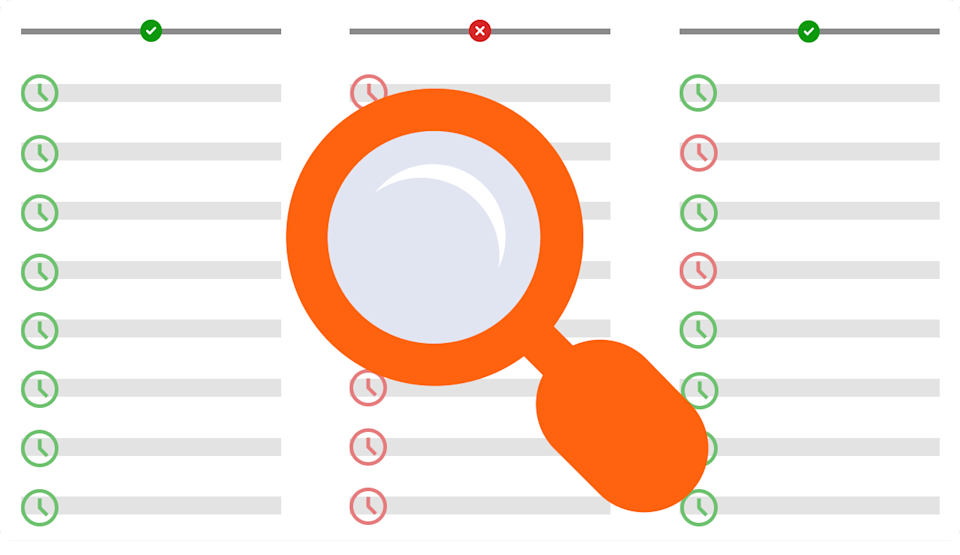
This post is the seventh in a seven-part series that uses a regulatory lens to explore how different dimensions of data quality can impact organizations—and how GX can help mitigate them. Read part 1 (schema), part 2 (missingness), part 3 (volume), part 4 (distribution), part 5 (integrity), and part 6 (uniqueness).
For this final entry in our data quality series, we’re turning our attention to a dimension that can make or break your analytics: data freshness. Stale data can make you miss opportunities, cause compliance issues, and create customer dissatisfaction. No matter your industry, mastering data freshness is essential to making the most of your data assets and maximizing your competitive edge.
The freshness challenge
We’ll continue our illustrative narrative at FinTrust Bank, a fictional financial institution. The data engineering lead at FinTrust, Samantha, has made significant progress with her data quality. But a few pressing issues remain:
Increased regulatory pressure for up-to-date reporting
Operational inefficiencies and customer complaints due to outdated information
Limitations in proactive fraud detection
These challenges are not unique to FinTrust. Whether you’re an e-commerce business struggling with inventory management or a financial services firm grappling with real-time fraud detection, maintaining suitably fresh data is a pervasive challenge.
Tackle data freshness head-on
To effectively maintain data freshness, you can’t make assumptions about what ‘fresh enough’ means for any given dataset: you need to get aligned with your business needs. This means collaborating with stakeholders to define acceptable freshness levels based on how the data is being used.
Before having these discussions, it can be helpful to prepare a set of guiding questions, such as:
What are the decisions you make or actions you take based on this data? How often do you do these?
How often do you need data to be refreshed to be most useful for your purposes?
How old can the data be before it is no longer useful for your purposes?
What are the consequences of using stale data for your decisions or actions?
It’s also useful to frame your discussion around specific business scenarios, so you can associate freshness requirements with concrete objectives. For instance, a fraud detection team might need real-time data to identify and prevent suspicious transactions, while a marketing team may be able to tolerate a few hours of lag in their campaign analytics.
Along with establishing requirements from the business side, you need to understand your data sources and pipelines. What’s the expected update frequency for each source? Are there inherent delays or complex processing steps that can impact freshness after data collection?
Mapping out these technical factors, you can set realistic freshness thresholds and implement monitoring for them.
The requirements-gathering process—for this dimension and others—can uncover conflicts between the business’ ideal requirements and the technical constraints of your systems. Don’t wait for these conflicts to be resolved to start monitoring your data freshness.
Instead, begin checking that the data is the best it’s currently capable of being, and update your tests when needed. Keeping all stakeholders aligned on what current realistic freshness goals are is an important function of your data quality monitoring.
For details on how freshness validation works in practice with GX, visit our technical documentation on data freshness.
Application: FinTrust Bank's journey
Samantha and her team knew that having fresh data was critical to meeting their regulatory obligations and delivering top-notch customer service. Using the strategic approach we outlined above, they began improving data freshness across the organization.
First, they initiated collaborative discussions with stakeholders from various departments, starting with the high-profile fraud detection, regulatory reporting, and marketing teams. They focused on understanding the specific business impacts of data freshness in each area.
By framing discussions around concrete scenarios, this step produced meaningful and specific requirements:
The fraud detection team affirmed that real-time data was critical for them in identifying and preventing suspicious transactions effectively.
The marketing department determined that a few hours of lag in campaign analytics wouldn’t significantly impact their decision-making process.
The regulatory reporting team highlighted strict timeline requirements for certain reports, which meant meeting precise freshness thresholds at specific times for some datasets.
With these requirements in hand, Samantha's team mapped out their data pipelines from source to destination. They created detailed flow diagrams for each critical dataset, annotating the expected update frequency and processing time at each stage.
This work allowed them to identify potential issues that could impact freshness. For instance, a legacy ETL process for their customer data was running on a schedule that didn’t match the source system’s update frequency. Optimizing this process and aligning the schedules allowed FinTrust Bank to significantly improve the freshness of this key dataset.
Armed with this deep understanding of their data landscape and their freshness requirements, Samantha’s team set up comprehensive freshness monitoring using GX. This included timestamp checks for critical datasets, data retention validation, and proactive alerts for staleness issues. With freshness rules codified in GX, FinTrust Bank could automate their data freshness validation and catch issues before they impacted the business.
📌 Quick win: leverage built-in freshness Expectations. Start with GX Cloud's prebuilt freshness Expectations like “Expect column max to be between” and “Expect column min to be between” to validate timestamp fields and quickly establish baseline monitoring for your critical datasets.
FinTrust Bank saw significant impact after implementing freshness monitoring:
They were able to confidently provide regulators with timely reports without unnecessary pre-deadline stress.
Their marketing team was able to make decisions based on current data, maximizing the impact of their efforts.
They saw fewer data-related customer complaints, strengthening their reputation and improving customer loyalty.
Looking ahead: The future of data freshness
As the demand for real-time analytics grows and data-driven decision-making becomes the norm, organizations that understand their data’s freshness will be in the strongest position. They’ll be able to meaningfully account for data freshness as a factor in their decisions and improve the timeliness of those decisions.
With stronger trust in their data internally and externally, organizations that have systematic data freshness monitoring will have a competitive advantage.
Join the conversation
How is your organization handling data freshness challenges? Join our community forum to share your experiences and learn from peers who are tackling similar challenges. Together, we can build more robust approaches to data quality management.
Key takeaways from this series
As we’ve seen through the example of FinTrust bank, tackling data quality effectively means working across multiple dimensions. It’s a many-layered—but critical—effort.
Here’s a recap of the issues that we tackled in this series:
Schema validation: Ensuring that your data adheres to a predefined structure.
Handling missing data: Detecting and managing null values effectively.
Data volume management: Scaling data quality practices as data size increases and understanding your expected data growth.
Distribution analysis: Understanding data patterns and identifying anomalies.
Data integrity: Maintaining accuracy and consistency throughout your data’s lifecycle.
Uniqueness validation: Ensuring the distinctness of critical data elements.
Data freshness: Validating that data is available when expected and as needed for successful business outcomes.
Powered by a data quality tool like GX, data practitioners like Samantha can use these tools and techniques to ensure high-quality, trustworthy data.


